AGRICULTURAL TECHNOLOGY GRADE 12 QUESTIONS - NSC PAST PAPERS AND MEMOS FEBRUARY/MARCH 2018
Share via Whatsapp Join our WhatsApp Group Join our Telegram GroupAGRICULTURAL TECHNOLOGY
GRADE 12
NSC PAST PAPERS AND MEMOS
FEBRUARY/MARCH 2018
INSTRUCTIONS AND INFORMATION
- GENERAL INSTRUCTIONS AND INFORMATION
1.1 This question paper consists of TWO sections, namely SECTION A and SECTION B.
1.2 BOTH sections are COMPULSORY.
1.3 Answer ALL the questions in the ANSWER BOOK.
1.4 Number the answers correctly according to the numbering system used in this question paper.
1.5 You may use a non-programmable calculator.
1.6 Write neatly and legibly. - SECTION A: SHORT QUESTIONS
2.1 This section consists of THREE questions.
2.2 Follow the instructions when answering the questions. - SECTION B: STRUCTURED LONG QUESTIONS
3.1 This section consists of FIVE questions.
3.2 Start EACH question on a NEW page.
QUESTIONS
SECTION A
QUESTION 1
1.1 Various options are provided as possible answers to the following questions. Choose the answer and write only the letter (A–D) next to the question number (1.1.1–1.1.10) in the ANSWER BOOK, for example 1.1.11 D.
1.1.1 Steel, alloyed with chromium and … , is resistant to air, water and chemicals.
- manganese
- copper
- nickel
- zinc
1.1.2 The preferred plastic for the manufacturing of heat-resistant handles:
- Bakelite
- Perspex
- Fibreglass
- Polyvinyl chloride
1.1.3 ONE of the following is NOT an advantage of Vesconite:
- Corrosion resistant and non-conductive
- Will not wear shafts like traditional bearing materials
- Is easy to join
- Resistant to a wide range of chemicals
1.1.4 The best type of fire extinguisher to be kept in a welding workshop is a/an … extinguisher.
- oxygen(O2)
- foam
- carbon dioxide(CO2)
- water(H2O)
1.1.5 Which ONE of the following should NOT appear on an electricity safety sign?
- Electricity
- Height of fence
- Shock
- High voltage
1.1.6 The function of the … in a vehicle is to ensure that the gears can be changed while the vehicle is moving.
- differential
- drive shaft
- clutch
- final drive
1.1.7 … increases the heat of the flame when welding with the oxyacetylene set.
- Argon
- Oxygen
- Acetylene
- Helium
1.1.8 Pneumatic tools operate with ... pressure.
- air
- oil
- hydraulic
- water
1.1.9 The hub-lock mechanism of a 4x4 vehicle is located at the ….
- rear wheels.
- rear differential.
- front wheels.
- torque converter.
1.1.10 The function of the sensitivity element on a tractor is to automatically …
- control the depth of the implement according to immediate soil conditions.
- adjust the cross angle of the implement in relation to the tractor's movement.
- increase torque to the power take-off shaft when the baler is impeded.
- lower or raise the back of the implement in relation to the movement of the tractor. (10 x 2) (20)
1.2 Change the UNDERLINED word(s) in each of the following statements to make the statements TRUE. Write only the word(s) next to the question number (1.2.1–1.2.5) in the ANSWER BOOK, for example 1.2.6 Tractor.
1.2.1 Electronic devices, like radios, can be used to activate the centre-pivot irrigation system.
1.2.2 Stretching of the V-belt is a common problem when using this type of belt over long distances.
1.2.3 Pure ethanol is commonly used as racing fuel.
1.2.4 The side of the hydraulic cylinder which contains the shaft, is stronger than the other side, because of the smaller contact area that is subjected to the oil pressure in the cylinder.
1.2.5 An oil fire should be extinguished with a foam fire extinguisher. (5 x 2) (10)
1.3 Choose a word/term from COLUMN B that matches the description in COLUMN A. Write down only the letter (A–H) next to the question number (1.3.1–1.3.5) in the ANSWER BOOK, for example 1.3.6 I.
COLUMN A | COLUMN B |
1.3.1 Battery acid, pesticides and solvents can lead to health hazards |
|
(5 x 2) (10)
TOTAL SECTION A: 40
SECTION B
QUESTION 2: MATERIALS AND STRUCTURES
Start this question on a NEW page.
2.1 Name FOUR safety properties that insulation material used in the roofs of buildings must adhere to. (4)
2.2 Electric fencing protects what is kept inside and keeps certain unwanted elements out.
2.2.1 Recommend TWO measures to ensure that humans do NOT accidently come into contact with an electric fence. (2)
2.2.2 Explain the use of ceramic isolators between the wire and the post of an electric fence. (2)
2.2.3 Briefly discuss the function of the appliance in the photograph below. 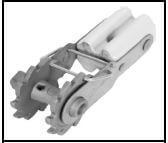 (2)
(2)
2.2.4 Describe what will happen to a person when he/she touches an electric fence if the amperage is too high. (2)
2.2.5 A battery, similar to the one below, can be used as a power source for an electric fence energiser. Name TWO types of batteries that can be used. 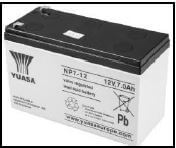 (2)
(2)
2.2.6 Explain the factors that have an influence on the earth return system of an electric fence. (4)
2.2.7 Describe THREE ways of increasing the earth efficiency of an electric fence in particularly poor earth conditions, like very dry soil. (3)
2.3 Teflon is an invention of chemical engineering and innovation. Name FOUR uses of Teflon on a farm. (4)
2.4 Vesconite is a thermoplastic made from polymers. Name THREE applications of Vesconite on farm implements. (3)
2.5 Explain why bronze is preferred for the manufacturing of propellers of huge ships. (2)
2.6 Name FIVE influences that manganese has on stainless steel. (5) [35]
QUESTION 3: ENERGY
Start this question on a NEW page.
3.1 Alternative ways of generating electricity are high on the priority list of countries all over the world because of the depletion of coal reserves.
3.1.1 Name FIVE different types of renewable energy sources used by modern society. (5)
3.1.2 What should NOT be done when you extract steam and hot water from a geothermal source to protect it from cooling down too much? (1)
3.2 The photograph below shows solar energy cells that provides electricity.
3.2.1 Explain the factors that have a negative influence on the effectiveness of a solar energy cell. (4)
3.2.2 Name TWO types of energy that are directly generated from solar energy. (2)
3.2.3 Name a device used with solar panels that change direct current to alternating current. (1)
3.3 The structures in the photograph below can be up to 100 metres high with blades that are 60 metres in length, making the structures susceptible to serious wind damage.
3.3.1 Recommend TWO actions to prevent the blades of the structures above from being damaged when they turn too fast during a strong wind storm. (2)
3.3.2 State FIVE advantages of using a small wind energy system on a farm. (5) [20]
QUESTION 4: SKILLS AND CONSTRUCTION PROCESSES
Start this question on a NEW page.
4.1 The questions below refer to metal inert-gas (MIG) welding.
4.1.1 Name the THREE most possible causes of poor penetration during MIG welding. (3)
4.1.2 Why is it NOT necessary to use additional flux when doing MIG welding? (1)
4.1.3 Give TWO reasons why MIG welding is quicker than conventional arc welding. (2)
4.1.4 Name the type of material used for manufacturing suitable protective clothing for welding. (1)
4.1.5 Give a reason for your answer to QUESTION 4.1.4. (1)
4.1.6 Explain why a little metal ball, as seen in the photograph below, burns to the contact tip of the MIG welding torch when welding. 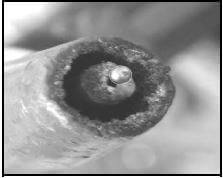 (2)
(2)
4.1.7 Describe TWO methods to remove the metal ball from the tip of the MIG welding torch. (2)
4.1.8 Name TWO different metals that can be welded successfully with a MIG welding machine. (2)
4.2 A welded joint on a planter has to be smoothed with the angle grinder, as shown below. Explain how you will achieve a neat final product. 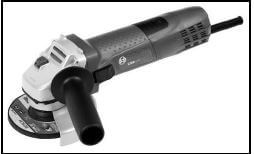 (5)
(5)
4.3 Describe the overhead arc welding procedure in the diagram below. 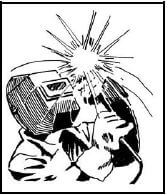 (4)
(4)
4.4 Below is a diagram of an oxyacetylene cutting set.
4.4.1 Recommend a device that can be used to light the flame of an oxyacetylene torch. (1)
4.4.2 Explain why it is NOT advisable to use a cigarette lighter or matches when igniting the oxyacetylene torch. (1)
4.4.3 Discuss the procedure that must be followed to shut down the oxyacetylene equipment after welding is finished. (5)
4.5 Explain how you will deal with hazardous gases when using a plasma cutter. (5) [35]
QUESTION 5: TOOLS, IMPLEMENTS AND EQUIPMENT
Start this question on a NEW page.
5.1 Study the photograph of a ram baler below and answer the questions that follow. 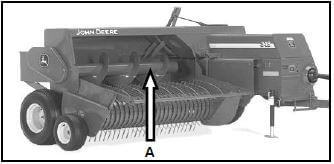
5.1.1 Identify component A. (1)
5.1.2 Explain the function of the ram. (2)
5.1.3 Name TWO functions of the slip clutch found in the drive mechanism of a baling machine. (2)
5.1.4 Describe FIVE procedures that must be followed before a baler is stored for a long period. (5)
5.2 Explain why it is necessary to use a four-wheel drive tractor with a front-end loader mechanism to move large round bales. (1)
5.3 A farmer wants to pump water from a river with an electrical motor and centrifugal pump. The diameter of pulley B on the electric motor is 200 mm and the speed is 3 750 r/min. The speed of pulley A on the centrifugal pump is 2 000 r/min. 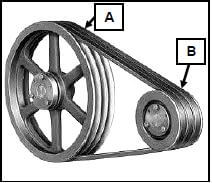
Na = speed of driving pulley
Da = diameter of driving pulley
Ng = speed of driven pulley
Dg = diameter of driven pulley
5.3.1 Calculate the diameter of pulley A on the pump. Show ALL calculations.
Use the formula: Na x Da = Ng x Dg (4)
5.3.2 The drive between the motor and the pump in the sketch above is brought about by V-belts. Name FOUR advantages of V-belts. (4)
5.4 The diagram below shows a plough hitched to a tractor. 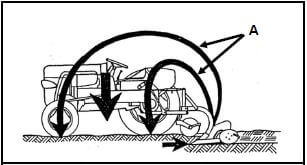
5.4.1 Analyse the diagram carefully and explain what arrow A illustrates. (3)
5.4.2 State THREE ways in which a farmer can change a tractor's mass displacement positively. (3)
5.4.3 Name THREE factors that have an influence on the forward movement of the tractor when ploughing. (3)
5.5 Explain the reason why a differential is installed in the rear axle of a tractor. (3)
5.6 Give FOUR causes why a tractor overturns. (4)
5.7 Name TWO places where the sensitivity element can be installed in a tractor. (2)
5.8 Name a medium that is used to drive EACH tool below. 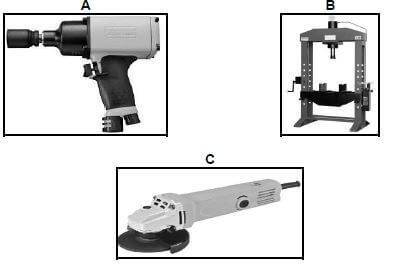 (3) [40]
(3) [40]
QUESTION 6: WATER MANAGEMENT
Start this question on a NEW page.
6.1 Name FOUR types of filtering systems that are used to purify water for human consumption and describe the working of EACH. (8)
6.2 What does GIS stand for and discuss how you would use it in a modern farming enterprise? (5)
6.3 Explain why a farmer must determine the flow rate of water in an irrigation system. (2)
6.4 Answer the questions below regarding septic drains used on farms to treat raw household sewage.
6.4.1 Name the most important substance found in any septic drain that ensures that it will function properly. (1)
6.4.2 Describe the function of the distribution box of a septic drain. (3) 6.4.3 Name THREE places where a septic drain should NOT be build. (3) 6.5 Below is a photograph of an irrigation timer. 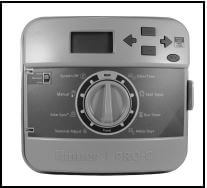
6.5.1 Explain the use of the irrigation timer above. (2)
6.5.2 Name TWO basic types of irrigation timers that can be used on a farm. (2)
6.5.3 List FOUR different types of irrigation systems. (4) [30]
TOTAL SECTION B: 160
GRAND TOTAL: 200